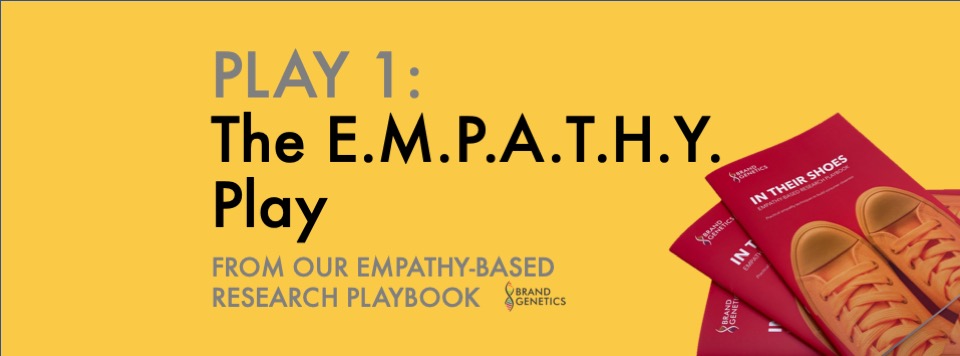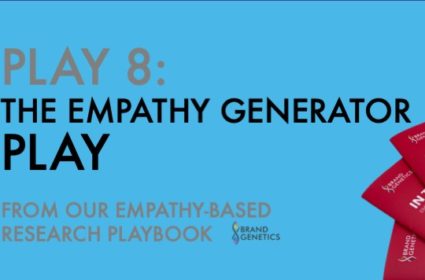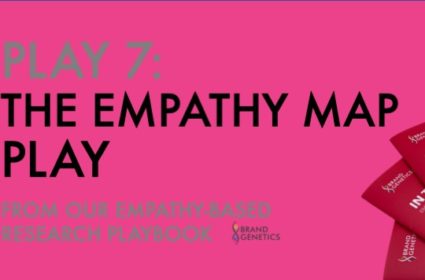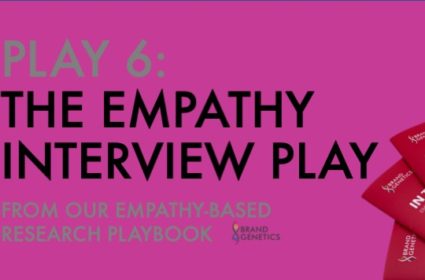Empathy-Based Research: The E.M.P.A.T.H.Y. Play

This article is part of our series on Empathy- based Research. You can view the full series or download the report.
Download ReportAs innovation and research becomes increasingly dominated by quantitative data analytics and algorithms, market researchers need empathy more than ever to see the humans behind the numbers. Empathy is our ability to see and feel things from someone else’s perspective, and the key benefit is that it generates emotional insight into the feelings, motivations and needs that drive behaviour. As a result, we’ve put together this playbook of practical empathy-based activities to help you research and innovate better from a consumer perspective.
Although some people are naturally more empathic than others, empathy is a skill that can be trained and improved in all. Over the coming weeks, we will be exploring each of the 8 plays from the playbook so that you have the skills you need to introduce human-first thinking into your business. When you need emotional insight, activate your powers of empathy first.
Download the full playbook now
Play 1: The E.M.P.A.T.H.Y. Play
When you need the play:
The E.M.P.A.T.H.Y. play involves applying a set of simple tricks from professional empathy training based on a mnemonic. The play works by optimising your personal capacity to see and feel things from somebody else’s perspective.
This play works well whenever you want to generate emotional insight into the feelings and motivations of the person you are with. It works best in one-to-one situations, such as an interview scenario with a consumer, colleague, expert or stakeholder.
How it works:
The E.M.P.A.T.H.Y. play takes time and practice to master. Start by picking the components with which you are most comfortable.
E is for Eye Contact. Our eyes reveal a wealth of information about what we are feeling, and by making an effort to check the eye colour of people you are talking to, you’ll train yourself to make eye contact. Don’t stare but use eye glances throughout a discussion.
M is for Muscles of Facial Expression. Look at people’s faces when listening or talking and you’ll find that your face may tend to automatically mimic the micro-movements of their facial expressions. This can prompt an emotional response in your own body, as your emotions line up with the facial expressions you are unconsciously mirroring. The phenomenon is known as “emotional contagion” – and describes how we quite literally catch the emotions of others by looking at their faces.
P is for Posture. Be sensitive to their posture and to your posture. It helps if you are facing them, leaning slightly forward, with your eyes at the same level. This creates a sense of equality, attentiveness and openness, and helps you be sensitive to non-verbal cues in their body language. You may find yourself naturally mirroring their posture throughout a discussion, and this may help you feel what they are feeling.
A is for Affect. Try to identify and label the particular emotions you are sensing in the other person as they speak. To do this, it helps to build your own emotional vocabulary (beyond just feeling good or bad, our emotional world is rich in nuance and diversity). Just as the world becomes more colourful, we have more words for colours, so too is it for our feelings. (Download the playbook for our recommended lexicon)
T is for Tone of Voice. Be attentive to their tone of voice, including the pace, pitch and rhythm of their speech. Tone of voice conveys about 40% of the non-verbal emotional content of what a person communicates, and can be more revealing than the actual words used.
H is for Hear the Whole Person. Set aside your own thoughts and judgements and really focus on what the individual is saying, imagining what it is like to be in their shoes. We often listen but don’t actually hear what the other is expressing, because we are distracted, preparing our response or making judgements.
Y is for Your Response. Be attentive to your own emotional and physiological responses. There is insight in your body’s response to what you are hearing, and by attending to this, you may increase the flow of emotional contagion, and feel what the other is feeling.
Click here to download your copy of the playbook now
If you want to be a more empathic business and introduce human-first insight and innovation – Brand Genetics can help. Get in touch today to find out more!




